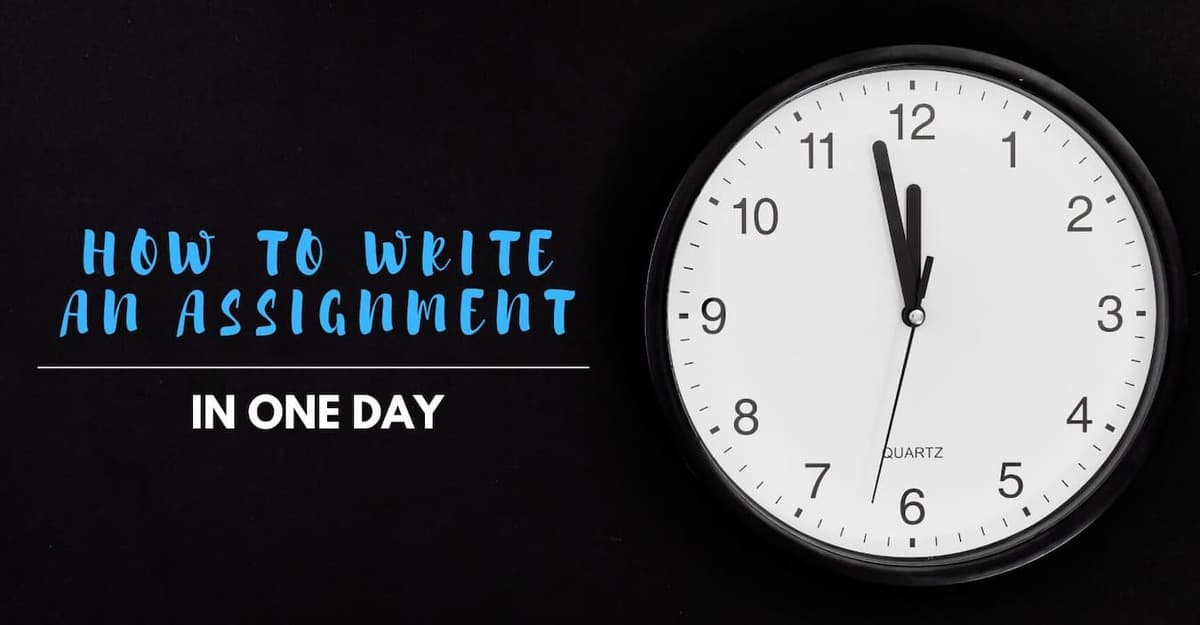If you’ve landed on this article, you probably don’t have much time. So, let’s jump right in with a step-by-step guide on how to quickly finish an assignment in just a single day.
Disclaimer: These tips are meant to help you complete the paper on time with passable quality. It’s going to be very difficult for most people to write an excellent assignment within just a single day. The word count also plays a big part on whether you can successfully do this in time.
If you have multiple assignments that are pending, be sure to also check our broader guide on how to catch up on school work fast.
Table of Contents
Make a rough outline and structure for your paper
You’re going to have to resist the urge to dive write into the writing part and take a few minutes to make a draft outline first. This is the most crucial step for getting to passable quality within a day. This is because you need to make sure that you know what the exact assignment requirements are. You can then write the paper with a focus on covering these points that are going to be essential to the grading.
Find the assignment requirements
This is usually given in a separate file but if you can’t find it, try to look for it in the grading criteria or rubric file, course outline, lecture notes or your teacher may have made notes on Canvas, Google Classroom, LMS etc.
Scan the assignment requirements to quickly find out what your teacher wants
We do have a dedicated guide on how to hack an assignment requirements file to make a quick outline for your paper. We highly recommend you check it out if you have time.
Divide these points into main headings and subheadings
Make a mental note on what should go in each of these sections
Check the word count requirement
Most assignments also have an allowance range of the word count, which is typically 10%. So, if you’ve got a 3,000-word assignment with a 10% tolerance range, then you only need to aim to write 2,700 words. Setting aside 200 words for the introduction and 200 words for the conclusion, you’re only going to need to about 2,300 words of fresh content.
Review the deadline (even if you have done it before)
After doing the previous steps, you should have a rough idea of what needs to go in your paper, which sections you need to focus on, and how long it could take. It is important that you review your deadline again to get some perspective on how much faster than usual you need to be working to complete the paper on time.
Use this as fuel to fight procrastination and resist the urge to take frequent breaks in between!
Set an alarm or reminder for the deadline
You can’t afford the luxury of chasing perfection in your assignment. Regardless of whether you are done with your assignment or not, you need to submit something by the deadline. This is assuming you don’t have a good excuse up your sleeve for not submitting on time, like having an approved deadline extension.
So, to make sure you don’t miss the deadline, make sure to set a reminder at least an hour before the actual deadline. You will need some buffer time to clean up any messy parts in your assignment and check for any obvious mistakes.

There is also the possibility that many of your fellow students are also working until the last minute on the same assignment. This means that the submission link could get hit with a lot of traffic and become inaccessible the closer you get to the deadline.
While such technical errors are often grounds for appealing for an extension, you’re going to be out of luck if you don’t have anything to prove that this happened. It may also be the case that you are the only one this seems to have happened to.
To be on the safe side, do not wait until the literal last minute. Try to upload your paper at least 20 minutes before the actual deadline.
Eliminate any and all distractions
If you haven’t got much time to go until the deadline, do not allow yourself to get distracted by anything!
- Stay away from social media, even if it’s just ‘to take a break’
- Don’t put on music or have a movie or show running in the background
- Put your phone on silent or switch it off if you have to!
If you absolutely need a break, just take a short walk or lie on the bed to get some rest. However, don’t forget to set an alarm if you are feeling drowsy.
Skim lecture notes to get some relevant points quickly
Once you have an outline of the headings and subheadings, you should quickly skim your lecture notes files. Most professors usually upload the lectures as presentations or PDF on your learning management system like Canvas.
Taking key points from the lectures and matching them to the subheadings of your assignment will help you stay rooted in what has been covered by your professors.

Use Wikipedia as a starting point
We have a detailed guide covering the use of Wikipedia for writing assignments without getting your teachers to roll their eyes. As you don’t have time now to read the whole thing, we can summarize it in the following points.
Search for the main topic of your assignment
Scan the Wikipedia article for most relevant sentences
Click on the links to the sources that have been cited for these sentences
Assess the credibility of the site which the links take you to
If the site passes the check, paraphrase the relevant parts and add to your paper
Make sure that you are directly referencing the original source and not Wikipedia!
Search for information relevant to your key points
Using the key points that you’ve discovered so far in steps #1, 5 and 6, start doing more detailed research on these specific points. Apart from the points that you’re specifically researching, you’re often going to come across other relevant points.
Having done the outline at the very beginning, you should have a better feel for which subheadings these other relevant points could relate to. With that understanding, keep asking yourself if all the other random information that you would be coming across are relevant for any of the identified sections of your paper.
Pad with quality content (paraphrasing, comments & examples)
We have a guide on how to boost the word count of your assignments without compromising the quality, but here’s the short version.
For nearly every paraphrased (and referenced) sentence that you add to your paper using the first tip, make sure that you are adding your own inference or comment right after it. If it seems appropriate and you can think of or find an example quickly, you could add that too. You can also try to include some counterarguments as well, if relevant. You can also do a quick search on Google for some statistics, facts or figures wherever appropriate.
Generate table of contents using heading styles
In case you didn’t know, there’s a handy feature within MS Word that allows you to automatically generate a table of contents section using just the headings and subheading of your assignment. Use it – this will save you precious time.
Review you work
If you’ve still got some time to go before the deadline, just give your paper a quick once-over. Try to spot typos, grammatical errors, and other mistakes that you would make when writing very quickly. The aim isn’t to make your paper perfect, but to remove obvious errors for which your professor may dock your grades. Just remember, if you want your paper to be flawless, make a note that you should start in advance next time!

